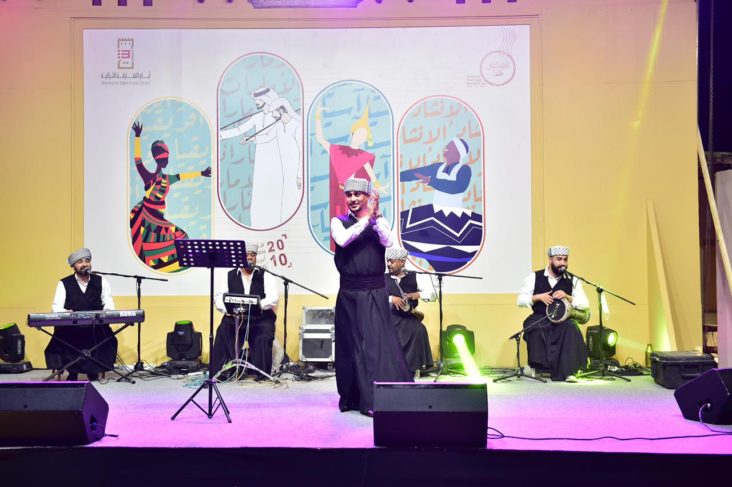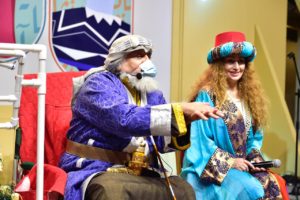Artistic Groups And A Variety Of Traditional Activities Spread Joy And Pleasure At Sharjah Heritage Days In Khorfakkan

The activities of Sharjah Heritage Days (SHD), organized by the Sharjah Institute for Heritage (SIH), continues in the “Heritage Area” of KhorFakkan for its third day, in light of a remarkable turnout of visitors from the public. The event, which is running with full preventative and precautionary measures in place, offers attendees a variety of programs, events, and activities, including the Art of the Habban, Iraqi art, storytelling, and more.
The “Art of the AlHabban” was performed by the Khorfakkan Culture and Public Arts Association Heritage in the arena of the heritage area, with folk dances to the sounds of the ‘Al Habban’ flute instrument providing watchers with stories of Emirati heritage and history. Additionally, the Iraqi Al Shamail troupe performed at the theatre, showcasing traditional Iraqi songs from southern and central Iraq, which attracted the admiration of the audience of citizens and residents.
Allows us to preserve the heritage of our beloved country and Sharjah
Aisha Ghabish, General Coordinator of Sharjah Heritage Days, said: “Under the generous patronage and support of His Highness Sheikh Dr Sultan bin Muhammad Al Qasimi, Member of the Supreme Council and Ruler of Sharjah, who considers heritage a bridge that brings together the world’s cultures and diversity, Sharjah Heritage Days has established itself as a major cultural heritage event. Sharjah Heritage Days is characterised by its strong presence of folk arts and traditional handicrafts, offering event-goers a look into the history of civilizations and countries that all settled in the districts of Sharjah.”
She added: “Vital participations also come from official institutions, whether through their pavilions, or through providing logistical services to the SharjahInstitute for Heritage to organize this great annual event. Sharjah Heritage Days is an important event which allows us to preserve the heritage of our beloved country and emirate of Sharjah.”
The “Hakawati” stories are full of lessons and wisdom, blending heritage, past and present
The storyteller has a long and ancient history, as the storyteller is the one who transmits and narrates stories, news and events, as well as providing wisdom ad lessons through stories. At the theatre in KhorFakkan heritage area, children were taken on a journey to the past through the art of storytelling, narrated by Abdel Nasser Al-Tamimi.
Abdel Nasser Al-Tamimi pointed out that he has narrated many stories, and that through his studies at the Sharjah Institute for Heritage, the foundations for his stories were laid. His specialty is telling old folk stories through a new and modern style, sprinkling them with folk proverbs and always finishing with a lesson at the end.
For her part, the media and artist Faten Abdullah, who participated in Al-Tamimi’s storytelling, said that she is honoured to participate and help the storyteller, enjoying the interaction of the children and the questions they ask. Prizes were given to the children for their interaction and good questions and answers they posed.
House of folk games- A memory of the past and a view of the present
Popular games are a symbol of culture and heritage for every country in the world, as they reflect history and tell a story of the times they originated from. Before the invention of technology such as television and radio, games were the height of entertainment for civilization, and a means for families and friends to gather. Sharjah Heritage Days event-goers can enjoy a display of old folk games in the heritage area of KhorFakkan, which have been played for hundreds of years. They also enjoyed live performances of games such as Al-Shabab, Yawani, Al-Qarhaif, the whirlpool, Gargee’anah, and others.
Home dye has a long history of colouring fabrics from natural herbs
The house for dyeing clothes in the heritage area of KhorFakkan displayed many tools that were used to dye clothes in the past, including plates for setting colours and fine turmeric, cochineal dye, fine henna paper, saffron, and wallors.
Maryam Ahmed Abdullah Al-Naqbi said: “We have recreated a room which was designated for dyeing clothes with the use of natural herbs. In the past, grandparents used to bring white clothes and fabrics and use these herbs to colour them, such as pomegranate, scarlet, henna, turmeric, and more.”


